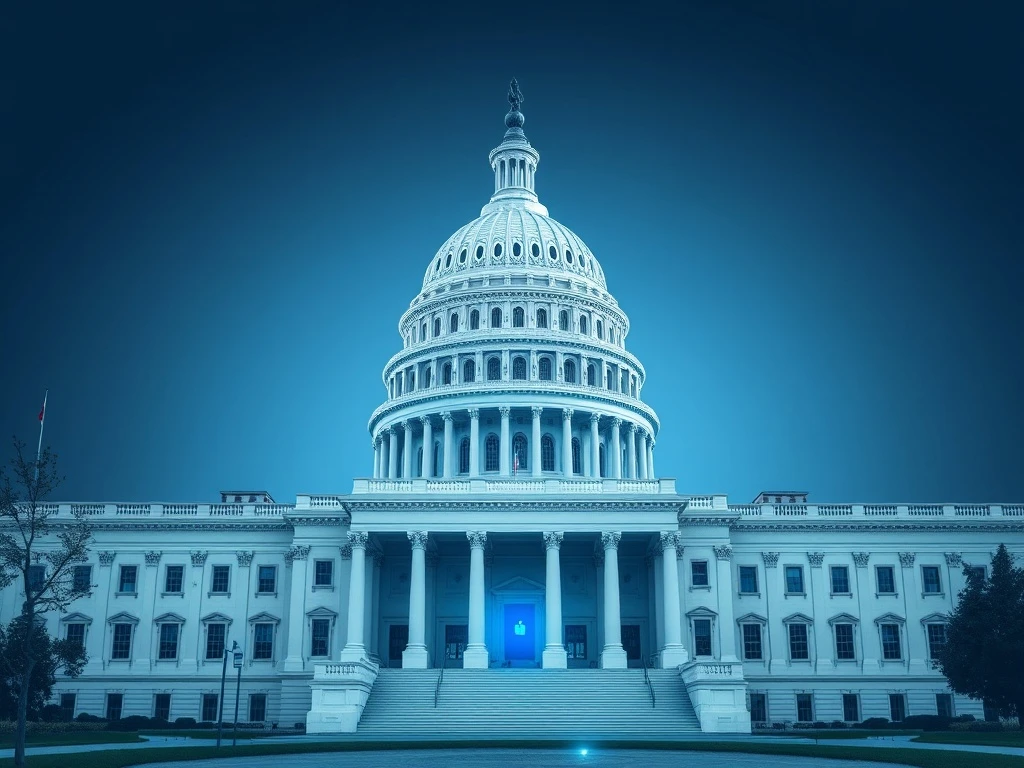Crucial Crypto Market Structure Bill Remains On Track Despite Government Shutdown

The landscape of **digital asset regulation** in the United States remains a topic of intense debate and anticipation. For many in the cryptocurrency community, the progress of key legislation is paramount. Recently, a significant update emerged concerning the **crypto market structure bill**, offering a glimmer of hope amidst political turbulence.
Wisconsin Representative Bryan Steil, a key figure behind the House of Representatives’ crypto market structure bill, the CLARITY Act, confirmed that the Republican timeline for passing this legislation by 2026 remains intact. This assurance comes despite the recent government shutdown, which fueled concerns across the industry. Steil’s remarks, made during a CNBC interview, underscored the ongoing commitment to establishing much-needed **regulatory clarity** for the burgeoning digital asset sector.
Navigating Legislative Hurdles: The CLARITY Act’s Pivotal Path
The **CLARITY Act** represents a significant legislative effort aimed at providing a clear framework for digital assets. It seeks to delineate the roles of various regulatory bodies, specifically the Securities and Exchange Commission (SEC) and the Commodity Futures Trading Commission (CFTC), in overseeing cryptocurrencies. This distinction is vital for innovators and investors alike. The House passed its version of the CLARITY Act in July, a key part of Republicans’ ‘crypto week’ initiatives. However, the bill’s journey to becoming law has faced delays since its transfer to the Senate.
Wyoming Senator Cynthia Lummis, a vocal advocate for crypto legislation, initially indicated that the Senate Banking Committee would vote on a bill building upon CLARITY by the end of September. This timeline was not met, even before the **government shutdown** began. Despite these setbacks, Representative Steil maintains an optimistic outlook. He expressed hope that legislators can quickly resume work on the bill once the shutdown concludes. Furthermore, he suggested that if the Senate adopts the House’s text as its foundation, the bill could still be signed into law by the year’s end.
Government Shutdown’s Shadow Over Digital Asset Regulation
The recent **government shutdown** created widespread uncertainty across federal operations, and the crypto industry was not immune. The shutdown, which began after lawmakers failed to pass a continuing resolution, impacted numerous federal agencies, leading to furloughs and limited services. While Congress remained in session, the legislative process inevitably slowed. House Speaker Mike Johnson reportedly stated that the chamber would not reconvene until the Senate acted to reopen the government.
For the crypto sector, one major concern centered on the US Securities and Exchange Commission (SEC). During the shutdown, the SEC operated with a significantly reduced staff and under modified conditions. This situation directly affected critical processes, particularly the review of cryptocurrency-linked exchange-traded fund (ETF) applications. These reviews were largely put on hold until normal operations resumed. While the SEC’s electronic filing system continued to accept submissions, the substantive progress on these applications paused, highlighting the direct impact of political gridlock on **digital asset regulation** and market development.
The Urgent Need for Regulatory Clarity in Digital Assets
The drive for **regulatory clarity** is paramount for the long-term health and growth of the cryptocurrency industry in the United States. A well-defined legal framework offers several crucial benefits:
- Investor Protection: Clear rules help safeguard consumers from fraudulent schemes and market manipulation.
- Market Integrity: Established guidelines foster fair and transparent trading environments.
- Innovation: Certainty allows businesses to build and expand without fear of retroactive enforcement or shifting regulatory sands.
- Global Competitiveness: A clear US stance can attract talent and capital, preventing companies from seeking friendlier jurisdictions abroad.
Without such clarity, the industry faces ongoing uncertainty, hindering investment and stifling innovation. This makes the passage of a comprehensive **crypto market structure bill** not just desirable, but essential for America’s role in the evolving digital economy.
Looking Ahead: Paths to Crypto Market Structure Bill Enactment
Despite the challenges posed by the **government shutdown** and prior delays, the pathway for the **crypto market structure bill** remains open. Representative Steil’s optimism suggests a continued push from key legislators. The proposal for the Senate to utilize the House-passed CLARITY Act text as its foundation could significantly expedite the process. This approach would bypass the need for extensive redrafting, potentially allowing for quicker committee votes and floor consideration.
The industry watches closely, recognizing that the legislative journey is often complex and subject to political currents. However, the consistent advocacy from figures like Steil and Lummis signals a sustained commitment to addressing the regulatory vacuum surrounding digital assets. The ultimate goal remains a robust and sensible framework that supports innovation while ensuring market stability and consumer protection. The coming months will be crucial in determining whether the 2026 timeline for comprehensive **digital asset regulation** can indeed be met, delivering the much-anticipated clarity the crypto community desires.









